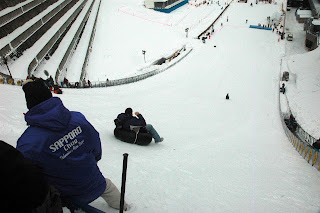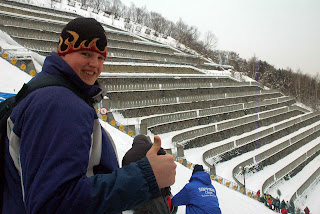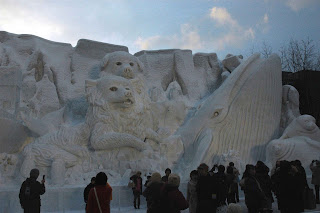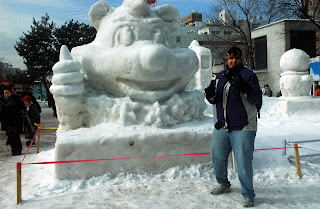From right before the snow festival. I'm almost caught up now.
最近私は怠け者です。先週は運動しなかった。今年はよくトレーニングをしたい。たくさんトレーニングのゴールがあります。私のいとこに尋ねる。私のいとこはトレーニングについて知っています。 For the last week or two, I neglected my almost daily exercises at the gym in favor of watching my friend Dan’s Battlestar Galactica DVDs. When he went to Hawaii for the winter holiday, he brought the second season’s DVD set for the Sci-Fi Channel’s program with him. So I have been busy watching Captain Apollo and Starbuck kill Cylons instead of pumping iron and working up a sweat at Peare, my local health club.
I am a little concerned now, because I am off track for one of my new year’s goals, which is to train myself and build muscles and a body I am truly proud of. And while this may seem to be a vain and worthless goal to many of you, I have discovered that this makes me feel better about myself, both physically and mentally, and gives me much more confidence than I normally have. My social confidence improves, as well as my self-esteem. I always compared myself unfavorably to friends and relatives of mine in both high school and university when it came to fitness. And while I realize now that most of my friends were far more active than I may ever be, I still have many lingering insecurities about my body image. Is this is a result of unrealistic standards in the media or a projection of deeper self esteem problems caused by school bullies and the misguided efforts of authority figures in my childhood? Or its some other combination of trendy psycho-babble buzz words from a sappy Oprah rerun that remains to be sorted out by a competent therapist in the future. Whatever my problem may be, I’m going to pump more iron until I figure it out. So despite the risk of becoming someone who admires himself in the mirror far too frequently (if I ever reach that point) I have resolved to return to the gym in the evenings with the goal of attaining a “respectable buffness” by the end of July. Yesterday, I returned with the utmost fervor and zeal.
A “respectable buffness” shall include the following attainable, yet ambitious physical goals:
1. A flat stomach with at least partially visible muscle tone. I don’t necessarily think I will achieve the “washboard” abs one sees on late night infomercials for exercise equipment, but some noticeable definition and shrinkage in the midsection. This will require an alteration in diet, a beefed up cardio regimen, and a more comprehensive set of midsection exercises (something I often neglect despite the amount of time I spend in the gym). And while I am resigned to the fact I that my ultimate ideal goal (Brad Pitt’s abs in “Fight Club”) is out of my league, a partial approximation of this cinematic standard would prove satisfactory.
2. More defined shoulders and upper arms. Since training in Japan, I have definitely improved in the shoulders through the military press. I would like to see further progress in this area, as well as biceps and triceps especially. I do not necessarily want an increase in size, but an increase in muscle tone.
3. Larger and more defined forearms. Since student teaching and coming to Japan, I have found that my forearm strength is slowly decreasing. This trend must stop. A perceptible increase in forearm size and strength is definitely in order. The daily use of my hang board is in order.
4. The ability to do 3 sets of 15 pull-ups and or chin-ups on a daily basis. This being another area in which I have slacked since my rock-climbing days, a discipline to work toward this on a daily basis should be sufficient. This could also be because my weight has increased slightly since coming to Japan. While a miniscule increase that is mostly muscle, I wonder if I am losing that critical “strength to weight ratio” that is necessary in the sport of rock climbing.
5. I wish to successfully complete the Koriyama City 10 mile run in 60 minutes or less, and complete the other local Towa Road Race Half Marathon in under 1.5 hours. My time last year for the 10 mile race was 73 minutes. I finished the Half Marathon in 1 hour and 43 minutes. As long as I start training regularly now, I think the 10 mile race goal of 60 minutes should be achievable with few problems. I have done the race before, and I think I am more experienced with both pacing during the race and good preparation. The first half of the Towa Half Marathon was uphill and I wasn’t adequately prepared for that at the time. My half marathon goal will definitely be ambitious, and I will definitely focus on my “hill-work” this coming spring. I also did the Half Marathon after an English Camp where I got no sleep. This shouldn’t be a problem this year. Training for these races should also provide most of the necessary boost to my cardio regimen necessary for objectives one, three, and seven.
6. Increased flexibility. During high school as I trained daily in Taekwondo, I attained an exceptional flexibility, especially in my legs. This is slowly disappearing as I frequently neglect this aspect of fitness. While my flexibility is still impressive for someone my age, I think that it should be better. I hereby put forth my objective: do the splits by the end of July. I will hereby resolve to stretch at my house daily after school.
7. A more defined back: A noticeable increase in visible muscle-tone would be nice. I do not wish to add muscle, only make the muscle I have stronger and more visible.
8. I will try to be more active on the weekends. As this year’s ski season is turning out to be a bust, I find myself spending less time than I thought doing physical activities. I must resolve to spend more time outside, and resist the natural impulse to be lazy and stay in my house. I am always happier when I do something physically active, even if motivating my self to do such things is often challenging.
Other challenges are appearing with my fitness and lifestyle lately. Since acquiring a Japanese driver’s license, I am spending more time driving (especially during bad weather) instead of riding my bicycle. To make matters more difficult, my main schools during the last two years fell within biking distance of my home, and gave me an extra 10-20 minutes of light aerobic activity. As my employer requires me to go to two much more distant schools in an all-expenses-paid taxi service, I spend much more time sitting on my big fat お尻 than I would prefer. I have tried to replace some of this activity by spending more time with the athletic clubs at school and joining PE classes when I have the time. Unfortunately, I am finding myself much busier than I was last year and lack the necessary free time at school.






